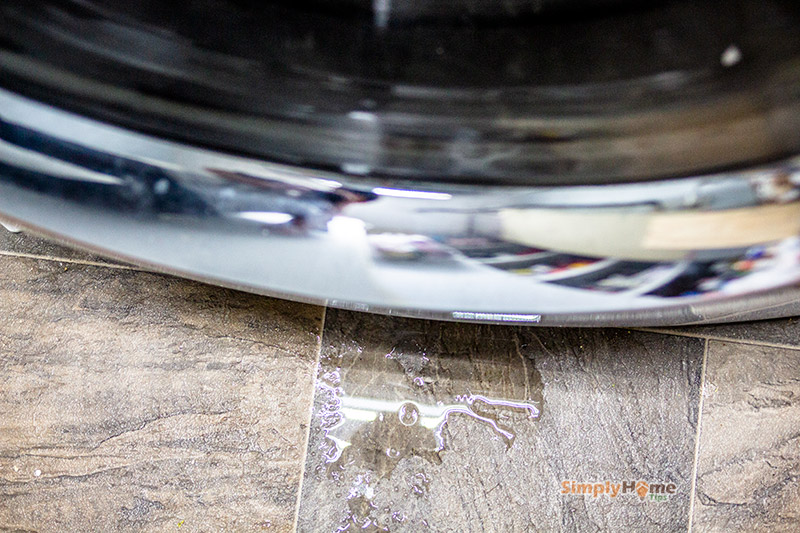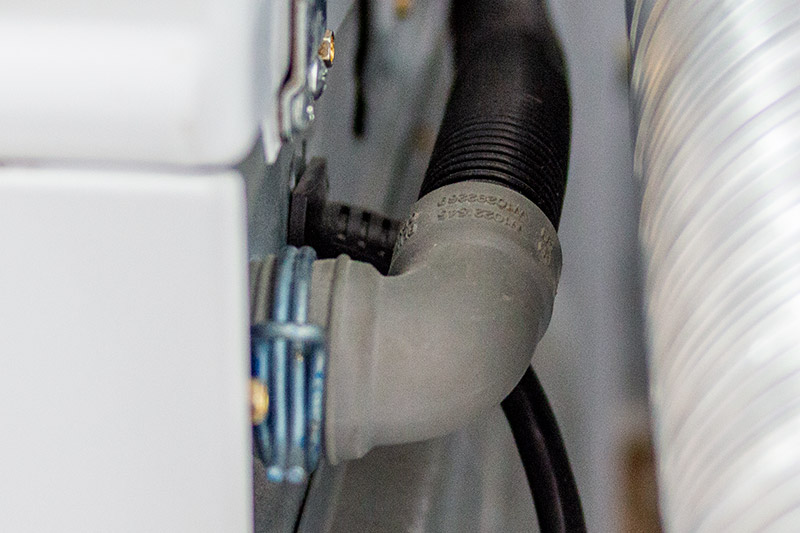Don’t panic when you find a puddle of water under your front-load washer. The three most likely problems are simple fixes that you may be able to take care of on your own. It really isn’t that difficult to repair the common causes of a leaky front-loading clothes washer. If you do decide to tackle these fixes yourself, unplug the machine before you begin working on it and wear protective gloves.
Common Easy-to-fix Causes of Leaking
1. Washer Door Seal (Leaking water from bottom of washer door)
Washer door seal or boot is the rubber gasket that seals the door on a front-load machine when it is closed. It can be torn or simply becomes too stiff to seal properly. In that case, water will leak from the door when the machine is filled. This is one of the most common problems.

Dirty or somethings stuck in the door seal
Open washer’s door and take a look at its door seal. Remove anything that stuck in it such as hair, clothes, socks, coin, etc… After that, clean the inner of washer door seal with a damp cloth. Then completely clean by running an empty cycle with baking soda and vinegar.
Worn or damaged door seal
Carefully inspect the door seal. If you find any cracks, tears or damages then it’s time to replace a new one.
2. Leaky Water Intake Hose Repair
A leaky water intake hose will usually cause water pooling at the back of the machine; however, the water could run toward the front of the machine if the floor is unlevel.
Things You Will Need:
- Crescent wrench or slip joint pliers
- Bucket
- Towel
How to Repair or Replace a Leaky Water Intake Hose:
- Turn the machine on so that water flows into the washer.
- Check the hose connections to the spigot and to the washer inlet valves as well as the length of the hose itself while water is flowing through the hoses. Be sure to fill with warm water so you can check both the hot and cold water hoses.
- Turn off the machine, if the water is leaking from the hose, and unplug it.
- Turn off the water supply at the faucets.
- Place the bucket directly below the hose.
- Turn the fitting counter-clockwise to unscrew the hose, if it is only leaking where it connects to the water inlet valve or faucet.
- Check for an O-ring in the hose fitting. It is a rubber ring that seals the hose when it is screwed onto the spigot.
- Replace the O-ring if it is missing or worn out. O-rings can be purchased at hardware stores.
- Replace the entire hose if it is cracked or punctured. Washer hoses are sold at hardware stores, appliance repair stores and online.
- Turn the fitting clockwise to screw the hose back onto the spigot or water intake valve at the washer. Tighten by hand then finish tightening with a crescent wrench or slip joint pliers.
- Dry the water up with the towel.
- Turn the washing machine on again to check for leaks.
- Repeat steps 1 through 11 if the hose is still leaking.
3. Clogged or Leaky Water Discharge Hose Repair
A clogged washer’s discharge hose will usually cause dirty water to back up into the machine. If the clog is in the drain pipe beyond the discharge hose, though, the dirty water can back up onto the floor. Depending on the severity of the clog, you may be able to save yourself some money by removing it yourself.

Things You Will Need:
- Drain snake
- Bucket
- Towel
How to clear a clogged drain pipe:
- Place the bucket below the washer discharge hose next to the drain pipe.
- Remove the washer discharge hose from the drain pipe.
- Set the end of the hose in the bucket.
- Run the drain snake into the drain until it meets resistance.
- Rotate the knob on the drain snake to advance it further into the clog.
- Pull the drain snake back out slowly after rotating it until it catches on the clog.
- Repeat steps 4 through 6 until the snake can be fed into the drain without meeting any resistance.
- Call a professional plumber if the problem persists.
Other Causes of Front-load Washer Leaking
Other common causes of front-load washer leaking should be repaired by a professional. They require in-depth knowledge of the appliance and special training for the repair to be completed safely and successfully. Attempting these washer repairs yourself could result in more extensive damage to the washer.
Other likely causes of washer leaking include:
- A malfunctioning water inlet valve assembly. The machine will overfill or underfill when this part isn’t working properly.
- Malfunctioning water-level pressure switch. A washer may overflow or not fill properly if this switch is broken or worn out.
- Cracked or broke outer wash tub. Washers have a moving inner metal basket that sits within a stationary plastic outer basket. A cracked or damaged plastic outer basket can leak wash water beneath the machine.
washer always overflows when on the clean cycle extensively
Reveiws of new washer water spilling when opening the door.Again on new Samsung machine WF50A8500AV
When my front load washer starts and the detergent drawer is emptying into the washer , water drippy out from under the front door